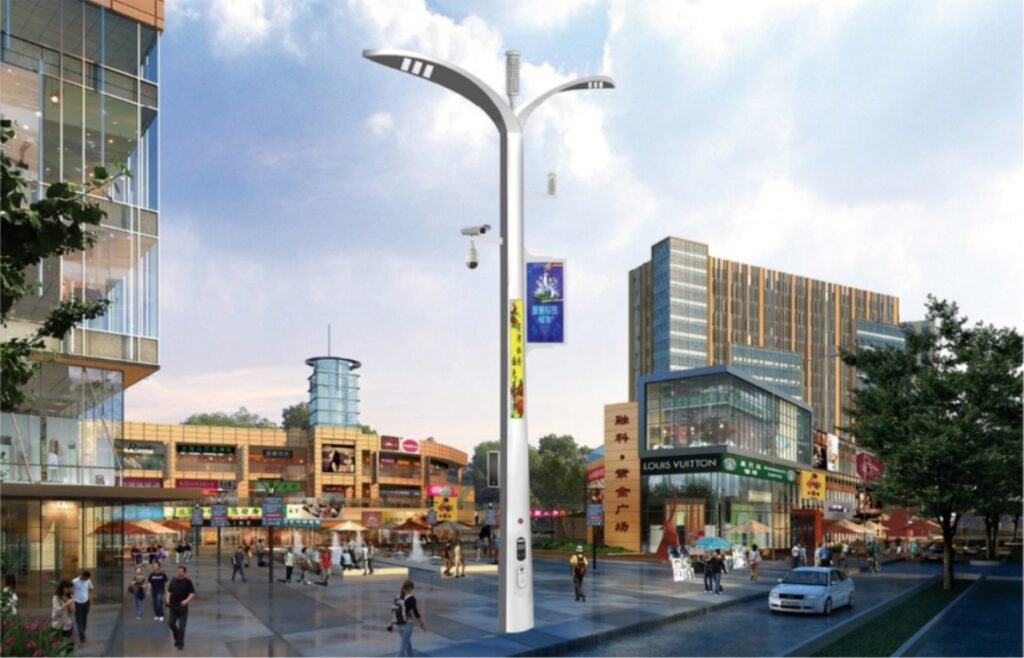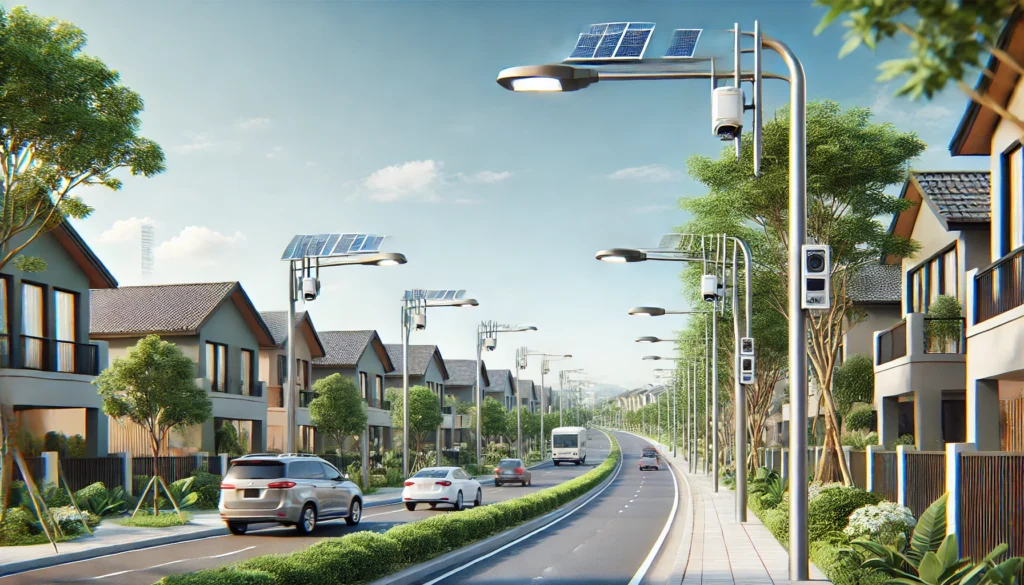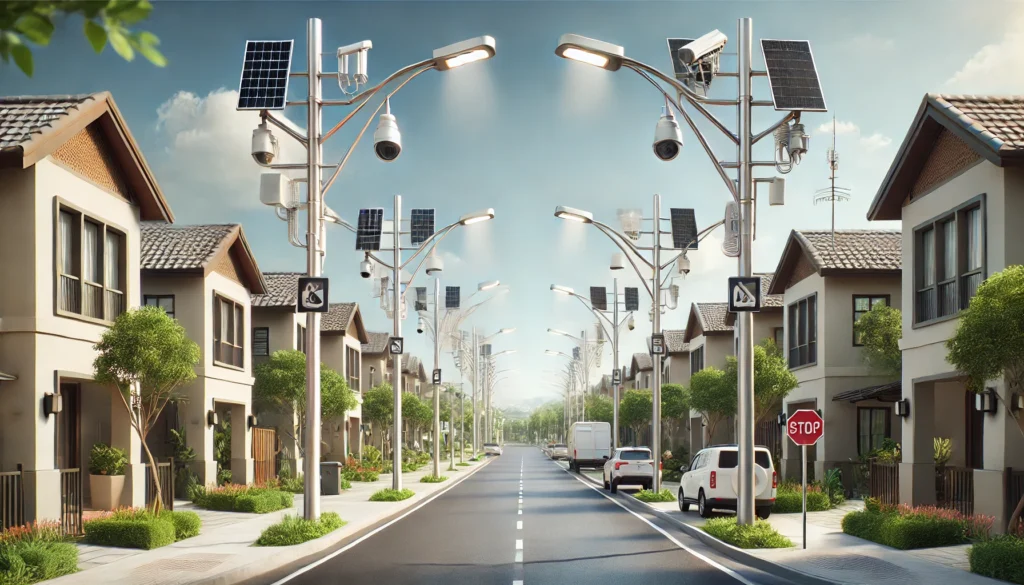1. Introduction
1.1 What are the benefits of smart street lights?
Street lighting plays a vital role in modern urban infrastructure. Traditionally, street lights operated on static schedules, leading to energy waste, increased maintenance costs, and unnecessary light pollution. However, smart street lighting is revolutionizing the way cities manage their lighting systems.
Smart street lights enhance efficiency, reduce costs, improve safety, and contribute to sustainability through intelligent control mechanisms. These advanced lighting solutions incorporate IoT technology, AI-driven automation, adaptive brightness, and predictive maintenance, ensuring optimal lighting conditions while conserving energy.

1.2 Why Smart Control is the Future of LED Street Lights
Traditional LED street lighting, while more energy-efficient than incandescent bulbs, still lacks intelligent management. Key challenges include:
- Inefficient energy use – lights remain on even when not needed.
- High maintenance costs – manual inspections and repairs increase expenses.
- Lack of adaptability – brightness levels cannot adjust to real-time conditions.
Smart control technology solves these issues by enabling:
- Real-time adaptive brightness based on traffic and environmental conditions.
- IoT integration for remote monitoring and management.
- AI-powered predictive maintenance to prevent failures.
- Sustainability through reduced energy consumption and light pollution.
1.3 About Our Company: Your Trusted Smart Lighting Partner
With decades of experience in LED and smart lighting solutions, we specialize in developing, manufacturing, and implementing high-performance street lighting systems. Our commitment to innovation, sustainability, and cost-effectiveness has positioned us as a trusted partner for cities and municipalities worldwide.

2. Understanding Smart Control in LED Street Lights
2.1 What is auto intensity control of street lights?
Auto intensity control refers to the ability of smart street lights to automatically adjust brightness based on real-time conditions. This functionality helps:
- Reduce energy consumption during low-traffic hours.
- Prevent excessive brightness, minimizing light pollution.
- Enhance safety by increasing illumination when needed.
2.2 Types of Smart Street Lighting Controls
Smart street lighting systems integrate various control mechanisms to optimize efficiency:
Traditional Switches vs. Smart Controllers
- Traditional switches require manual operation and do not adjust brightness.
- Smart controllers automate brightness adjustment and enable remote control.
Motion Sensors (Occupancy Sensors, Microwave, PIR)
- Detect pedestrian or vehicular movement.
- Increase brightness when activity is detected and dim when no movement is present.
- Commonly used in low-traffic areas and parking lots.
Photocells (Dusk-to-Dawn Sensors)
- Automatically turn lights on/off based on ambient light levels.
- Help reduce manual intervention and optimize energy usage.
Timers & Dimming Schedules
- Pre-programmed schedules adjust brightness based on predicted traffic flow.
- A combination of timers and photocells ensures efficient lighting operation.
Wireless Intelligent Control Systems (IoT-Based)
- Centralized remote monitoring & control via cloud platforms.
- Predictive maintenance alerts for proactive repairs.
- Integration with smart city infrastructure for optimized urban management.

3. Key Benefits of Smart-Controlled LED Street Lights
3.1 How do LED lights improve energy efficiency?
LED street lights already consume less energy than traditional bulbs, but smart control systems maximize efficiency even further by:
- Reducing unnecessary lighting usage through adaptive brightness control.
- Automating on/off schedules to align with real-time conditions.
- Using AI-driven power management to optimize energy distribution.
3.2 Cost-Effective & Low Maintenance
- Smart monitoring detects faults remotely, reducing the need for manual inspections.
- Predictive maintenance extends LED lifespan, lowering replacement costs.
- Up to 40% maintenance cost reduction compared to traditional street lights.
3.3 Enhanced Public Safety & Urban Mobility
- Brightens roads and pathways when movement is detected to improve visibility.
- Seamless integration with traffic management & emergency response systems.
- Prevents crime by ensuring well-lit public spaces.
3.4 Environmental Sustainability
- Reduces carbon footprint by lowering energy consumption.
- Minimizes light pollution to protect wildlife and human health.
- Supports integration with solar power and renewable energy sources.

4. Real-World Case Studies & Data-Backed Insights
4.1 Smart Street Lighting in Major Cities
- Singapore: AI-driven smart lighting reduced energy consumption by 35%.
- Amsterdam: IoT-controlled street lights resulted in 60% maintenance cost savings.
- Dubai: Integrated smart lighting contributed to a 25% reduction in carbon emissions.
4.2 Our Success Stories
- Our smart lighting solutions have helped municipalities reduce costs, improve safety, and optimize energy use.
- Customer testimonials & energy savings reports validate the long-term benefits of smart control technology.
5. Smart Control Technologies & IoT Integration
5.1 AI & Machine Learning in Smart Lighting
- AI analyzes traffic patterns to optimize lighting schedules.
- Self-learning algorithms reduce power wastage and improve efficiency.
5.2 IoT & Wireless Connectivity
- LoRa, Zigbee, NB-IoT, 5G enable seamless communication between lights.
- Remote monitoring platforms provide real-time diagnostics and failure alerts.
5.3 Integration with Smart City Infrastructure
- Connects with traffic systems, security cameras, and public utilities.
- Improves city-wide energy management and emergency response efficiency.
6. Cost-Benefit Analysis: Smart LED Street Lights vs. Traditional LEDs
6.1 How do you design efficient street lights?
| Feature | Traditional LED Street Lights | Smart-Controlled LED Street Lights |
|---|---|---|
| Energy Efficiency | Moderate | High (30-50% savings) |
| Maintenance Costs | High (manual inspections) | Low (predictive maintenance) |
| Adaptability | Fixed brightness | Adaptive brightness (motion, ambient sensors) |
| Remote Monitoring | Not available | IoT-based real-time diagnostics |
| Sustainability | Energy-efficient but not optimized | Integrated with renewable energy |

7. Overcoming Challenges in Implementing Smart Street Lights
7.1 Initial Investment vs. ROI
- Smart lighting offers long-term savings despite a higher initial cost.
- Energy savings offset costs within 3-5 years, making it a cost-effective solution.
7.2 Compliance & Industry Standards
- IEC 62471 (Photobiological safety of LED lights).
- ISO 50001 (Energy management).
- IEEE 802.15.4 (Wireless communication for IoT integration).
7.3 Cybersecurity & Data Privacy Concerns
- Encryption and secure protocols protect IoT-connected lighting systems.
- Best practices for smart city cybersecurity ensure data integrity.
8. The Future of Smart LED Street Lighting
8.1 AI-Powered Autonomous Street Lighting
- Self-adjusting brightness based on real-time weather and traffic.
8.2 Integration with 5G & Edge Computing
- Faster data processing enhances real-time control and efficiency.
8.3 Renewable Energy & Self-Sustaining Smart Street Lights
- Solar-powered smart lighting reduces grid dependence.
8.4 Self-Healing Networks & Predictive Fault Detection
- AI-driven maintenance alerts prevent system failures.
9. Conclusion & Call to Action
9.1 Why Smart-Controlled LED Street Lights are the Future
- Energy efficiency, cost reduction, safety, and sustainability.
9.2 Why Partner with Us?
- Industry-leading smart lighting solutions with proven results.
9.3 Get Started Today
- Contact us to implement smart-controlled LED street lighting and optimize urban energy use today! 🚀

